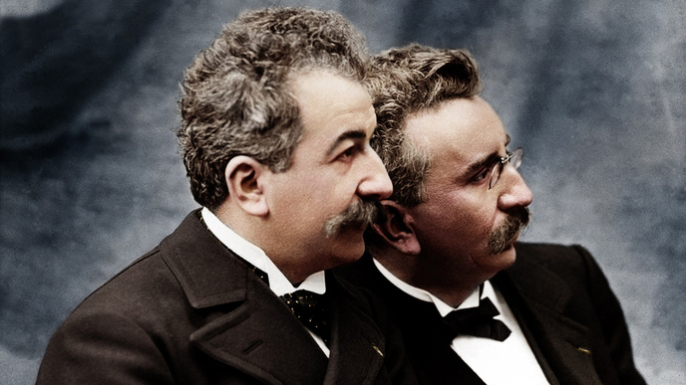
First commercial movie screened on December 28, 1895
First commercial movie screened: On this day in 1895, the world’s first commercial movie screening takes place at the Grand Cafe in Paris. The film was made by Louis and Auguste Lumiere, two French brothers who developed a camera-projector called the Cinematographe. The Lumiere brothers unveiled their invention to the public in March 1895 with a brief film showing workers leaving the Lumiere factory. On December 28, the entrepreneurial siblings screened a series of short scenes from everyday French life and charged admission for the first time.
Movie technology has its roots in the early 1830s, when Joseph Plateau of Belgium and Simon Stampfer of Austria simultaneously developed a device called the phenakistoscope, which incorporated a spinning disc with slots through which a series of drawings could be viewed, creating the effect of a single moving image. The phenakistoscope, considered the precursor of modern motion pictures, was followed by decades of advances and in 1890, Thomas Edison and his assistant William Dickson developed the first motion-picture camera, called the Kinetograph. The next year, 1891, Edison invented the Kinetoscope, a machine with a peephole viewer that allowed one person to watch a strip of film as it moved past a light.
In 1894, Antoine Lumiere, the father of Auguste (1862-1954) and Louis (1864-1948), saw a demonstration of Edison’s Kinetoscope. The elder Lumiere was impressed, but reportedly told his sons, who ran a successful photographic plate factory in Lyon, France, that they could come up with something better. Louis Lumiere’s Cinematographe, which was patented in 1895, was a combination movie camera and projector that could display moving images on a screen for an audience. The Cinematographe was also smaller, lighter and used less film than Edison’s technology.
The Lumieres opened theaters (known as cinemas) in 1896 to show their work and sent crews of cameramen around the world to screen films and shoot new material. In America, the film industry quickly took off. In 1896, Vitascope Hall, believed to be the first theater in the U.S. devoted to showing movies, opened in New Orleans. In 1909, The New York Times published its first film review (of D.W. Griffith’s “Pippa Passes”), in 1911 the first Hollywood film studio opened and in 1914, Charlie Chaplin made his big-screen debut.
In addition to the Cinematographe, the Lumieres also developed the first practical color photography process, the Autochrome plate, which debuted in 1907.
History Channel / Wikipedia / History of the motion picture - Encyclopedia Britannica / Biography / Alchemists /
Cinema of France-1895-Auguste and Louis Lumiere-The first real motion picture ever made-First comedy (YouTube)” 
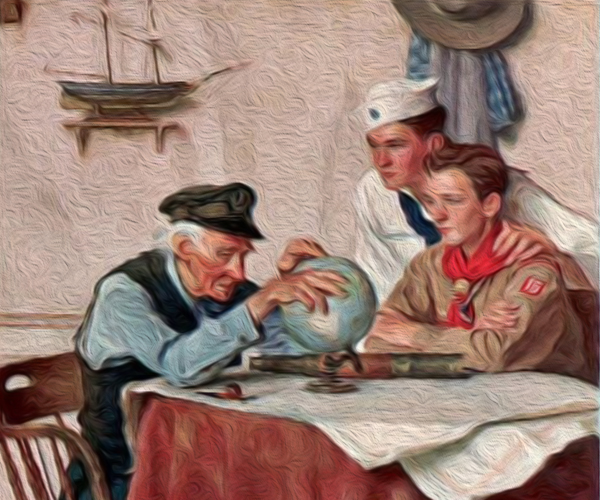
Understanding Military Terminology - Maritime Superiority
(DOD) That degree of dominance of one force over another that permits the conduct of maritime operations by the former and its related land, maritime, and air forces at a given time and place without prohibitive interference by the opposing force. Joint Publications 3-32 (Command and Control for Joint Maritime Operations)

The Old Salt’s Corner
“Crossing the Bar”
Sunset and evening star,
And one clear call for me!
And may there be no moaning of the bar,
When I put out to sea,
But such a tide as moving seems asleep,
Too full for sound and foam,
When that which drew from out the boundless deep
Turns again home.
Twilight and evening bell,
And after that the dark!
And may there be no sadness of farewell,
When I embark;
For though from out our bourne of Time and Place
The flood may bear me far,
I hope to see my Pilot face to face
When I have crossed the bar.
~ Alfred, Lord Tennyson (1889)

“I’m Just Sayin”
“The comments on any article about feminism justify feminism.”
~ Lewis's law

“Thought for the Day”
“He who closes his ears to the views of others
shows little confidence in the integrity of his own views.”
~ William Congreve

“What I Have Learned”
“Every storm, no matter how big and strong, passes eventually.
Just know and remember that your spirit is much bigger
and stronger than any storm that comes your way,
and that all storms will fall apart long before you ever would.”
~ Doe Zantamata

Bizarre News (we couldn’t make up stuff this good – real news story)

The one body part you should never get pierced - as tattoo parlour brands it “incredibly unsafe”
Piercing and body art has become increasingly commonplace, and with the ongoing trend, fans are getting more and more creative.
But there is one type of piercing which should be avoided - and the warning is coming from a professional piercer - “Snake eyes” tongue piercing - the style is in fact a curved barbell inserted horizontally through the tip of the tongue.
Mirror (10/19/2016) 

Mr. Answer Man Please Tell Us: If you are on the surface of Earth, and you walk one mile South, one mile West, and one mile North, where will you end up?
Depends on your starting point. On the North pole: the same place.
On the North pole: the same place. Somewhere else on the northern hemisphere: some distance less than a mile to the west.
On the southern hemisphere: some distance more than a mile to the west. (1+1/(2*n*Pi))miles from the south pole: same place. Less than a mile from the south pole: undefined.
Business Insider
• Mashable
• Maxim
• Quora
The Science Explorer (YouTube)” 

Where Did That Saying Come From?
“Brevity is the soul of wit:” Meaning: There's no briefer way of expressing this thought than Shakespeare's; making further explanation redundant.
Origin: From Shakespeare's Hamlet, 1602:
LORD POLONIUS
This business is well ended.
My liege, and madam, to expostulate
What majesty should be, what duty is,
Why day is day, night night, and time is time,
Were nothing but to waste night, day and time.
Therefore, since brevity is the soul of wit,
And tediousness the limbs and outward flourishes,
I will be brief: your noble son is mad:
Mad call I it; for, to define true madness,
What is't but to be nothing else but mad?
But let that go.
English Stack Exchange - Phrases.org UK

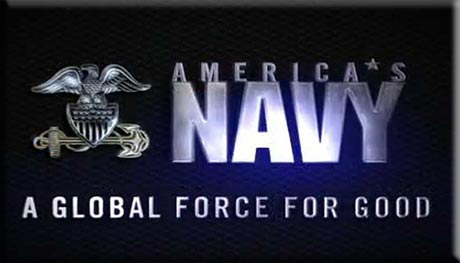
NAVSPEAK aka U.S. Navy Slang
Missile Sponge: Usually a frigate or destroyer with limited air defense capability stationed on the outer ring of a battlegroup, as they are the ships most likely to be hit in a convoy.
Miss Shit Can: The USS Michigan (SSGN-727).
Mobile Chernobyl USS Enterprise (CVN-65), due to it being the first nuclear-powered aircraft carrier. See “Quarter Mile Island” below.


Just for you MARINE
NAVY: Never Again Volunteer Yourself, Never Actually Ventures Yonder, pejorative backronym used by sailors who regret volunteering or are otherwise dissatisfied with their post.
NBCD: Nuclear, Biological, Chemical Defense. See also CBRN. Need Bitches Call, No Body Cares.
NCIS:, Naval Criminal Investigative Service the primary law enforcement agency of the DoN, also a television show of the same name.

Naval Aviation Squadron Nicknames
VT-2 - Fixed Wing Training Squadrons: “Doerbirds”
Formerly Basic Training Group-2 (BTG-2) Re-designated VT-2 on May 1, 1960 Primary TRAWING 5 / Naval Air Station Whiting Field, Santa Rosa County near Milton, Florida
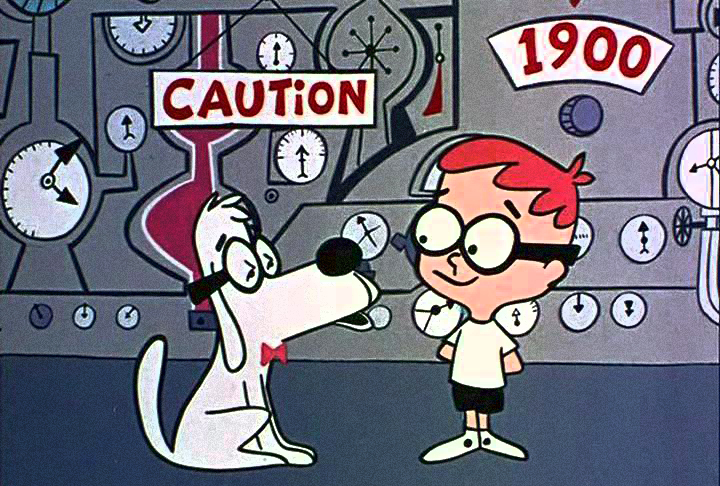
Science & Technology

A step towards LIMITLESS energy on Earth: MIT's fusion reactor sets a new world record for plasma pressure
• The “impossible” fuel-free engine that may one day take humans to Mars in 10 WEEKS gets an upgrade: Patent reveals improved EmDrive design
• “Our polling methods are bunk:” Political science professor says pollsters have NO IDEA who will vote in November
• The empathy map of the world: the table in results even the researchers admit are “surprising”
• Are you using the English language correctly? Take the Oxford University quiz that reveals the phrases we all get wrong
Daily Mail

The Strange, Mysterious or Downright Weird
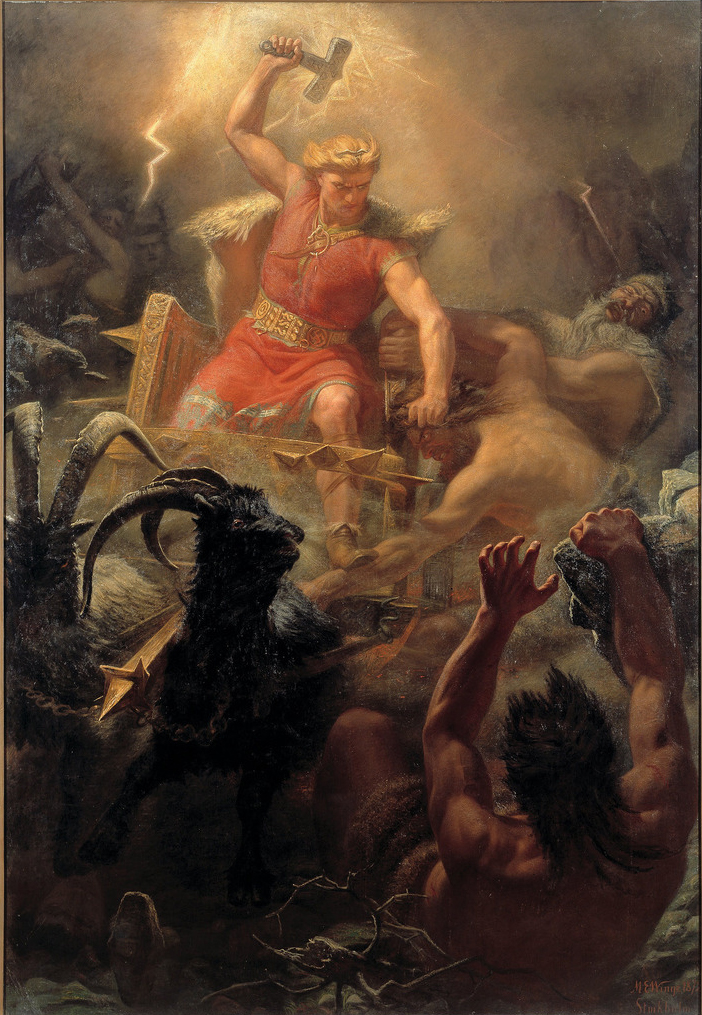
(Inside Science) — Lightning is one of the most destructive forces in nature. But for all the folklore and legends amassed over human history on lightning, we know surprisingly little about the inner workings of this powerful phenomenon, including something as simple as how the current that flows through a thunder-inducing flash is related to the temperature of the strike.
“A direct hit from a lightning strike can melt a power cable or start a forest fire, where the amount of heat from the lightning plays a major role”, said Xiangchao Li, a scientist from China who specializes in lightning research. Li and his team discovered a mathematical relationship between the current intensity and the temperature inside lightning. Their result was published last month in the journal Scientific Reports.
Although there are approximately 100,000 lightning strikes on Earth every single day, the randomness of the occurrences makes it difficult for scientists to study them in an effective or systematic way. So until Thor, the Norse god of lightning as well as other meteorological events, joins a lightning research team, scientists are left to their own devices.
With a better understanding of the physics of lightning, scientists can help engineers to improve current protocols and infrastructures to better deal with lightning -- from weather warning systems to the design of power grids. Perhaps we can one day limit the power of Thor to only smiting Loki on the silver screen.
Live Science (11/16/2016) 


SONG FACTS

“Carry On Wayward Son” - Kansas
Album: Leftoverture
Released 1976 
Written by Kansas guitarist Kerry Livgren. According to Livgren, the song was not written to express anything specifically religious, though it certainly expresses spiritual searching and other ideas.
Livgren became an evangelical Christian in 1980, and has said that his songwriting to that point was all about “searching”. Regarding this song, he explained: “I felt a profound urge to 'Carry On' and continue the search. I saw myself as the 'Wayward Son,' alienated from the ultimate reality, and yet striving to know it or him. The positive note at the end ('Surely heaven waits for you') seemed strange and premature, but I felt impelled to include it in the lyrics. It proved to be prophetic.”
This was the group's first major hit, and like their next one, “Dust In The Wind”  , it was a last minute addition to the album. Kerry Livgren wrote the song just two days before they started recording Leftoverture. At that point, the band was polishing the songs they had, not bringing in new ones. “I've got one more song that you might want to hear”, he told the band, and when he played “Carry On”, they knew it was a hit and made it the lead track on the album.
, it was a last minute addition to the album. Kerry Livgren wrote the song just two days before they started recording Leftoverture. At that point, the band was polishing the songs they had, not bringing in new ones. “I've got one more song that you might want to hear”, he told the band, and when he played “Carry On”, they knew it was a hit and made it the lead track on the album.
This song has appeared in several movies, including Heroes (1977), Happy Gilmore (1996) and Anchorman - The Legend of Ron Burgundy (2004).
The album Leftoverture not only propelled Kansas to international stardom, it also saved the band for the time being. Kansas' previous record, Masque, was a commercial failure, and the progressive style of the band and their songs hindered their ability to get serious radio play. While he personally enjoyed the band, producer Don Kirshner gave Kansas one last chance: produce a hit record, or be dropped by the label. Overwhelmed and distressed with the predicament, the band returned to their hometown of Topeka, Kansas, to relax and begin writing for the next album.
Lead singer and keyboard player, Steve Walsh, began suffering from writer's block which hindered his songwriting contributions, and so it was left up to lead guitar player and lyricist, Kerry Livgren, to generate song ideas and lyrics. Sitting at his parent's home, in front of the family organ, Livgren composed the music for what would become “Carry On Wayward Son”. In late 2011, Livgren stated in a short interview at his home that the lyrics were partially about himself and the struggles and pressures he was facing at the time when the band's career was on the line. The piano interlude and accompanying verse express how happy the band's success had made him, as well as how sad and fearful he was that it might possibly be over (“I was soaring ever higher, but I flew too high”). However, the chorus expresses hope that everything will work out and that he must simply keep going. (“Carry on, my wayward son. There'll be peace when you are done”).
In reality, the song was almost not included on the album, and thus contributes to the album's title of Leftoverture. The album title comes from the idea that many of the songs are leftover songs from the band's past. The album, while met with mixed reviews by critics, was commercially successful, going platinum five times. “Carry On” became the bands' first Top 40 hit, and is often regarded as one of the greatest rock songs of all time. It gave Kansas the staying power it needed to keep producing records with Kirshner, and earned Kerry Livgren the reputation as one of the most respected musicians and lyricists in rock and roll.
Kansas official site / Billboard / All Music / Song Facts / Wikipedia
Image: “Leftoverture (album)” by Kansas

Trivia
● Hula Hoop is one of the most popular toys of all time - as a plastic ring with a Hawaiian name
● FROGS or toads are two common names for jumping, tailless amphibia
● Which plant has the largest seeds? Coconut because they are the seeds.

A Test for People Who Know Everything
College bowl games: a. Name the bowl game named after a Spanish party? b. Name the bowl game named after an animal. c. Name the bowl game named after a greeting.
● Answer for People Who Do Not Know Everything, or Want to Verify Their Answer FBS Schedules
Answer to Last Week's Test
What is Santa's favorite breakfast cereal?
Answer: Frosted Flakes Just Riddles and More

Joke of the Day
A Lesson In Morals
One day at the end of class, little Johnny's teacher asks the class to go home and think of a story to be concluded with the moral of that story.
The following day the teacher asks for the first volunteer to tell their story.
Little Suzy raises her hand. “My dad owns a farm and every Sunday we load the chicken eggs on the truck and drive into town to sell them at the market. Well, one Sunday we hit a big bump and all the eggs flew out of the basket and onto the road.”
When the teacher asked for the moral of the story, Suzy replied, “Don't keep all your eggs in one basket.”
Little Lucy went next. “My dad owns a farm too. Every weekend we take the chicken eggs and put them in the incubator. Last weekend only eight of the 12 eggs hatched.”
Again, the teacher asked for the moral of the story.
Lucy replied, “Don't count your chickens before they hatch.”
Next up was little Johnny. “My uncle Ted fought in the Vietnam war, and his plane was shot down over enemy territory. He jumped out before it crashed but could only take a case of beer, a machine gun and a machete. On the way down, he drank the case of beer. Then he landed right in the middle of 100 Vietnamese soldiers. He shot 70 with his machine gun, but then he ran out of bullets! So he pulled out his machete and killed 20 more. Then the blade on his machete broke, so he killed the last ten with his bare hands.”
The teacher looked a little shocked. After clearing her throat, she asked what possible moral there could be to this story.
“Well”, Johnny replied, “Don't f**k with Uncle Ted when he's been drinking.”
Pun of the Day
Why not take a break in the south of France? You've nothing Toulouse.


























